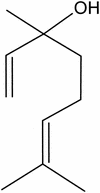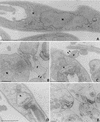Antileishmanial activity of a linalool-rich essential oil from Croton cajucara
- PMID: 12760864
- PMCID: PMC155815
- DOI: 10.1128/AAC.47.6.1895-1901.2003
Antileishmanial activity of a linalool-rich essential oil from Croton cajucara
Abstract
The in vitro leishmanicidal effects of a linalool-rich essential oil from the leaves of Croton cajucara against Leishmania amazonensis were investigated. Morphological changes in L. amazonensis promastigotes treated with 15 ng of essential oil per ml were observed by transmission electron microscopy; leishmanial nuclear and kinetoplast chromatin destruction, followed by cell lysis, was observed within 1 h. Pretreatment of mouse peritoneal macrophages with 15 ng of essential oil per ml reduced by 50% the interaction between these macrophages and L. amazonensis, with a concomitant increase by 220% in the level of nitric oxide production by the infected macrophages. Treatment of preinfected macrophages with 15 ng of essential oil per ml reduced by 50% the interaction between these cells and the parasites, which led to a 60% increase in the amount of nitric oxide produced by the preinfected macrophages. These results provide new perspectives on the development of drugs with activities against Leishmania, as linalool-rich essential oil is a strikingly potent leishmanicidal plant extract (50% lethal doses, 8.3 ng/ml for promastigotes and 8.7 ng/ml for amastigotes) which inhibited the growth of L. amazonensis promastigotes at very low concentrations (MIC, 85.0 pg/ml) and which presented no cytotoxic effects against mammalian cells.
Figures





Similar articles
-
In vitro cytocidal effects of the essential oil from Croton cajucara (red sacaca) and its major constituent 7- hydroxycalamenene against Leishmania chagasi.BMC Complement Altern Med. 2013 Oct 2;13:249. doi: 10.1186/1472-6882-13-249. BMC Complement Altern Med. 2013. PMID: 24088644 Free PMC article.
-
Antileishmanial activity and trypanothione reductase effects of terpenes from the Amazonian species Croton cajucara Benth (Euphorbiaceae).Phytomedicine. 2015 Nov 15;22(12):1133-7. doi: 10.1016/j.phymed.2015.08.012. Epub 2015 Sep 18. Phytomedicine. 2015. PMID: 26547537
-
Antileishmanial activity of Eugenol-rich essential oil from Ocimum gratissimum.Parasitol Int. 2006 Jun;55(2):99-105. doi: 10.1016/j.parint.2005.10.006. Epub 2005 Dec 15. Parasitol Int. 2006. PMID: 16343984
-
Morinda citrifolia Linn. fruit (Noni) juice induces an increase in NO production and death of Leishmania amazonensis amastigotes in peritoneal macrophages from BALB/c.Nitric Oxide. 2016 Aug 31;58:51-8. doi: 10.1016/j.niox.2016.06.004. Epub 2016 Jun 18. Nitric Oxide. 2016. PMID: 27328771 Review.
-
Plant active components - a resource for antiparasitic agents?Trends Parasitol. 2005 Oct;21(10):462-8. doi: 10.1016/j.pt.2005.08.004. Trends Parasitol. 2005. PMID: 16099722 Review.
Cited by
-
Green Synthesis of Silver and Titanium Dioxide Nanoparticles Using Euphorbia prostrata Extract Shows Shift from Apoptosis to G0/G1 Arrest followed by Necrotic Cell Death in Leishmania donovani.Antimicrob Agents Chemother. 2015 Aug;59(8):4782-99. doi: 10.1128/AAC.00098-15. Epub 2015 Jun 1. Antimicrob Agents Chemother. 2015. PMID: 26033724 Free PMC article.
-
Plants with anti-Leishmania activity: Integrative review from 2000 to 2011.Pharmacogn Rev. 2013 Jan;7(13):34-41. doi: 10.4103/0973-7847.112840. Pharmacogn Rev. 2013. PMID: 23922454 Free PMC article.
-
Antifungal Effect and Inhibition of the Virulence Mechanism of D-Limonene against Candida parapsilosis.Molecules. 2022 Dec 14;27(24):8884. doi: 10.3390/molecules27248884. Molecules. 2022. PMID: 36558017 Free PMC article.
-
In vitro antileishmanial and cytotoxicity activities of essential oils from Haplophyllum tuberculatum A. Juss leaves, stems and aerial parts.BMC Complement Altern Med. 2018 Feb 14;18(1):60. doi: 10.1186/s12906-018-2128-6. BMC Complement Altern Med. 2018. PMID: 29444667 Free PMC article.
-
Antileishmanial activity of the essential oil from Tetradenia riparia obtained in different seasons.Mem Inst Oswaldo Cruz. 2015 Dec;110(8):1024-34. doi: 10.1590/0074-02760150290. Epub 2015 Nov 24. Mem Inst Oswaldo Cruz. 2015. PMID: 26602873 Free PMC article.
References
-
- Agner, A. R., M. A. Maciel, A. C. Pinto, and I. M. Colus. 2001. Antigenotoxicity of trans-dehydrocrotonin, a cleorodane diterpene from Croton cajucara. Planta Med. 67:815-819. - PubMed
-
- Alexander, J., A. R. Satoskar, and D. G. Russel. 1999. Leishmania species: models of intracellular parasitism. J. Cell Sci. 112:2993-3002. - PubMed
-
- Angioni, A., A. Barra, M. Arlorio, J. D. Coisson, M. T. Russo, F. M. Pirisi, M. Satta, and P. Cabras. 2003. Chemical composition, plant genetic differences, and antifungal activity of the essential oil of Helichrysum italicum G. Don ssp. microphyllum (Willd.) Nym. J. Agric. Food Chem. 51:1030-1034. - PubMed
-
- Barakiewicz, J., H. M. Dosch, and A. Cohen. 1988. Extracellular nucleotide catabolism in human B and T lymphocytes: the source of adenosine production. J. Biol. Chem. 263:7094-7098. - PubMed
Publication types
MeSH terms
Substances
LinkOut - more resources
Full Text Sources
Medical

